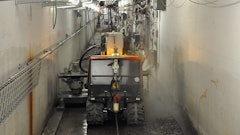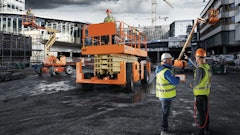
Today's compact telehandlers are so versatile, so agile and so downright productive that they rival skid steers as the most useful piece of construction equipment on the jobsite.
Skid steers can dig more efficiently for longer periods of time than compact telehandlers, and full-size telehandlers can lift heavier loads to higher heights, but when it comes to material moving and lifting, a compact telehandler is hard to beat.
A staple in European agriculture for some time, compact telehandlers arrived on U.S. construction sites around 10 to 15 years ago. For European contractors, compact telehandlers have proven to be essential fleet machines for moving in and around tight spaces. Currently, the machines are very popular here on this side of the pond due to their versatility. Their popularity should continue to grow as manufacturers work on increasing the reach and capacity of these models. Models being introduced today offer a reach of around 19 feet, a barrier that manufacturers promise will be broken in the future.
Now one of the fastest-growing segments of the North American construction equipment market, compact telehandlers are used in landscaping, construction and municipal applications. They can place trees on slopes, extend sod over a freshly graded area, transport materials around the jobsite, load and unload trucks and the list goes on.
"Because of its versatility, telehandlers are often the first machine on many jobsites and the last to leave," says Luke Webber, senior market analyst at Genie Industries. "Their primary markets are construction and institutional. Common applications include parking garages, strip mall construction, new construction, multi-story construction, steel erecting, masonry, framing and landscaping."
Between a rock and a hard place
Compact telehandlers are much smaller dimensionally than traditional telescopic models. JLG's new super compact G5-18A, for example, measures 12 feet long, 71.5 in. wide and just 6 ft. 4 in. tall. Add a 126-inch outside turning radius to its small footprint and you have a machine ideally suited to working in tight spaces such as parking garages and inside buildings that don't have commercial truck doors.
Compacts are also easier to transport than their bigger brothers. Weighing in at between 9,000 and 14,000 pounds, compact telehandlers can be towed by a pickup truck and trailer, which means your customers can drive away with them, leaving you with one less delivery to make.
Designed primarily as lifting machines, compact telehandlers can lift and place materials to a height of a two-story building. Full-size models can go much higher, of course, but for many general contractors, the two-story height is more than adequate.
A tool carrier, too
Today's compact telehandlers are not just for lifting and placing applications, they are also adept at utilizing a variety of ground-engaging attachments such as buckets, augers, grapples and brooms.
Because of its boom design ? which is typically two-stage vs. three- or even four-stage ? a compact machine can do much more extensive loader work than its larger counterparts. And because some compact telehandlers can accommodate universal skid steer attachments, there's virtually no end to the attachment options.
"Unlike typical construction machines which utilize primarily a carriage and forks, compact telehandlers spend a great deal of their life with a bucket attached to the boom," says Brian Boeckman, product parent, North American Telehandlers, JLG Industries Inc.
Genie Industries also promotes the ability of its newly redesigned GTH-5519 to use skid steer attachments. "The manual Genie Quick-Attach system comes standard on the GTH-5519," says Webber. "It allows for fast, easy attachment connection. The hydraulic Quick-Attach system is optional. It connects and locks attachments in seconds while the operator remains in the cab."
Optional Genie attachments include the universal skid steer adapter, which allows the operator to pull up and attach a wide variety of skid steer-type attachments. The industrial grapple bucket, heavy-duty multi-purpose bucket, truss boom and a variety of rotate/side-shift fork carriages are also available.
Boeckman says JLG also offers a universal skid steer attachment. Manufacturers that do say the ability of compact telehandlers to use skid steer attachments really opens the door of possibilities. If you already own a skid steer, you don't have to go out and buy a whole new series of attachments.
Cab comfort
Despite their diminutive size, today's compact telehandlers are able to accommodate larger operators. "The GTH-5519 was redesigned with the operator in mind," says Webber at Genie. "Ergonomic placement of foot pedals and joystick, as well as tilt steering, adjustable seat, power steering and armrest provide the operator comfort with minimal effort."
Most models are available with an enclosed cab and air conditioning and many offer simplified controls as well. The G5-18A from JLG, for example, offers lift/loader mode, a switch in the cab that allows the operator to choose the preferred motion. In lift mode, the x-axis of the joystick moves the boom in and out, while in loader mode, it tilts the attachment up and down."
To improve jobsite productivity, the Genie GTH-5519 comes standard with a fully proportional, reversible and continuous auxiliary hydraulic flow control that allows the operator to adjust the auxiliary hydraulic system for the attachment chosen for the job.
Stacking up against skids
With their compact design that can fit in tight spots on every jobsite, as well as the ability to use a variety of attachments, including those designed for a skid steer, what does a skid steer have that a compact telehandler doesn't?
"The only thing we give up is the counter rotation," says Ford at Manitou, noting that with four-wheel steer and the tight turning radius that a compact telehander offers, they're extremely maneuverable machines.
When it comes to cost, compact telehandlers are about equal to large skid steers. Both machines hover around $50,000. "End-users like the compacts because there's no need to climb over attachments, for starters," says Ford. "They also like that when they climb into a telescopic, it's very common territory with automotive-style contols."
Return on investment
One major benefit to compact telehandlers over full-size machines is the return on investment potential. Compacts cost about 15 percent less than traditional models, but offer a huge amount of versatility. They can command the same rental rate, translating into higher profits.
The rental perspective
"I became interested in the compact telehandler market in 2002," recalls Bob Kalhagen, president of Ideal Crane Rental Inc. in Madison, WI. "At that time, the smallest forklift we had in our fleet was a SkyTrak 5028. Even though this machine was rated at 5,000 lbs., it was a fairly bulky machine. Many jobsites we were renting equipment at only needed a small four-wheel drive telehandler to unload trucks and spot materials around a jobsite.
"We started out with a [Manitou] Model MLT 523. One of our first customers was a pole barn buider who attached a post hole auger to the quick-attach on his Manitou. He would drill the holes and then set trusses with a truss boom. The customer was able to pull the forklift and attachments with his one-ton pickup truck from job to job.
"Another customer dug landscape ponds in the backyards of homes. He liked the machine because of its digging abilities with a bucket, the travel speed, smooth ride and telescoping boom to place boulders for waterfalls. He sold his skid steer."
Kalhagen concludes, "The most popular attachments we rent are buckets and truss booms. We also rent out an adapter plate so than any skid steer attachment will fit onto a Manitou. The attachments are all rented separately from the telehandler that comes standard with forks and carriage."





























